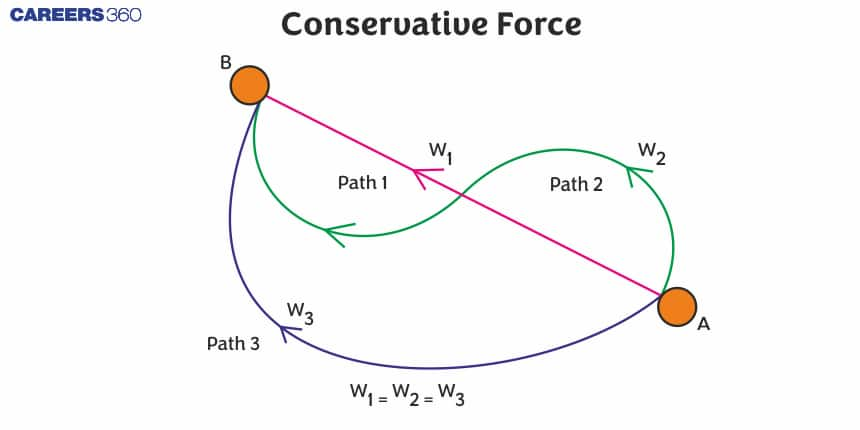Conservative Force - Properties, Examples, FAQs
What is Conservative Force?
A conservative force is one that is applied to move a particle from one point to another while remaining independent of the particle's route. It is solely determined by the particle's starting and final positions. Conservation forces include gravitational and elastic spring forces, for example. Gravity is a classic example of a conservative force. Magnetic, electrostatic, and elastic forces are more examples.
JEE Main/NEET 2027: Physics Important Formulas for Class 10
NEET 2025: Mock Test Series | Syllabus | High Scoring Topics | PYQs
JEE Main: Study Materials | High Scoring Topics | Preparation Guide
JEE Main: Syllabus | Sample Papers | Mock Tests | PYQs
- What is Conservative Force?
- Properties of Conservative Force
- Examples-
- What is Non-Conservative Force?
- Difference Between Conservative and Non-Conservative Force

Properties of Conservative Force
A force is said to be conservative if it possesses the properties listed below.
- When the force is solely determined by the initial and final positions, regardless of the path followed.
- The work done by a conservative force on any closed path is zero.
- The work done by a conservative force can be reversed.
Also read -
- NCERT Solutions for Class 11 Physics
- NCERT Solutions for Class 12 Physics
- NCERT Solutions for All Subjects
Examples-
- Gravitational Force
Assume you're at the top of a ladder and you drop a ball. The gravity will be estimated while the ball is at its maximum height and again when it reaches the ground as a conservative force.
Gravitational force = m × g,
Where m is the mass of the ball and g is the acceleration due to gravity.
Therefore work done by the gravitational force
W = -mgh
Where h is the difference between the initial and final position of the body.
$h=h_{\text {final }}-h_{\text {initial }}$
We can simply find out the work done by gravity on the particle using the above expression just by knowing the vertical displacement, regardless of how intricate the particle's journey is. We can deduce from this that the gravitational force is independent of the path traveled, but only of the initial and final positions. As a result, gravitation is a conservative force.
- Magnetic Force
The force of magnetism is a conservative force. Any two electrically charged particles moving together produce a magnetic force, which is a relative phenomenon. The magnetic force is a conservative force since it is a velocity-dependent vector.
- Electrostatic Force
The force of electrostatic attraction is a conservative force. The work done by an electrostatic force in the presence of an electric field is determined by the charge's initial and ending positions, not its path. The electrostatic force is a conservative force since it is route-independent.
|
Related Topics, |
What is Non-Conservative Force?
A non-conservative force is one whose output is dependent on the path chosen. Friction is an example of a force that is not conservative. If a force causes a change in mechanical energy, which is equal to the total of potential and kinetic energy, it is said to be non-conservative. A non-conservative force's work adds or subtracts mechanical energy. Thermal energy is dissipated when work is done by friction, for example. It is impossible to restore all of the energy that has been lost.
Properties of Non-Conservative Force
Its properties are the opposite of conservative forces. The following are the properties:
- Because it is path-dependent, it is also affected by the initial and final velocity.
- The total work done by a non-conservative force in any closed path is not zero.
- The work done by a non-conservative force is irreversible
NCERT Physics Notes :
Difference Between Conservative and Non-Conservative Force
|
Conservative Force
|
Non-Conservative Force
|
|
|
|
|
|
|
Also, check-
Frequently Asked Questions (FAQs)
The force acting on an object that is directed along the line between the object and the origin is known as the central force.
Yes, the electric field is a conservative field.
A field where conservative force can be experienced is called a conservative field.
The SI unit of work done is joule (J).
Friction is a force that is non conservative. Work is required to overcome the effect of frictional force when a body is moved against friction. The work done by the frictional force is determined not only by the body's initial and ultimate positions, but also by the length of the path travelled.
Also Read
05 Feb'25 04:38 PM
11 Jan'25 03:12 PM
03 Dec'24 04:00 AM
03 Dec'24 03:48 AM
29 Nov'24 11:10 AM
28 Nov'24 01:12 AM
27 Nov'24 11:57 PM
27 Nov'24 02:41 PM
27 Nov'24 02:15 PM
26 Nov'24 03:04 PM